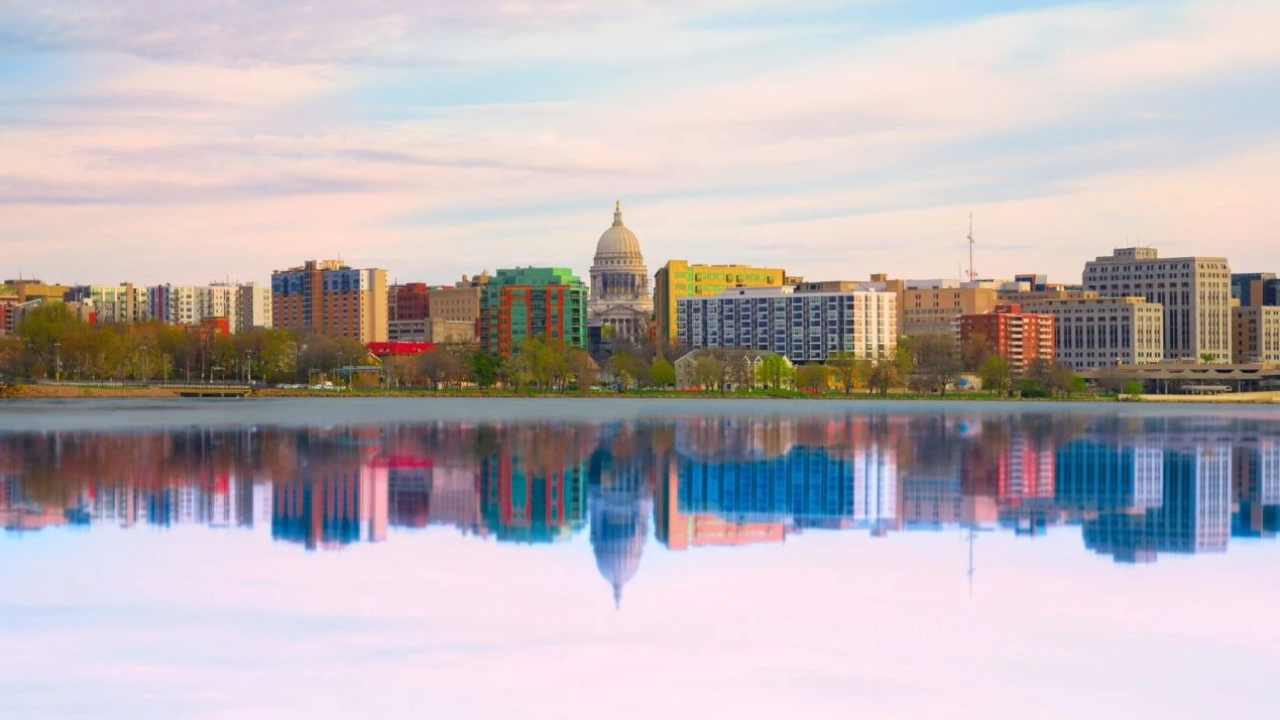As more Americans seek affordable places to live in the face of ever-increasing home prices, many are looking to mid-size cities in the middle of the country. Using metrics ranging from educational attainment to the cost of living, a new study from Real Estate Witch found that Madison, Wisconsin, is the top up-and-coming city in America, followed closely by a dozen other college towns.
In fact, 12 of the top 15 cities are home to a major college or university. College towns are known for being walkable and diverse, with lots of cultural amenities — features that appeal far beyond the student body.
The top 15 up-and-coming U.S. cities in the U.S. are:
- Madison, Wisconsin
- Fargo, North Dakota
- Lincoln, Nebraska
- Provo, Utah
- New Haven, Connecticut
- Omaha, Nebraska
- Ann Arbor, Michigan
- Fayetteville, Arkansas
- Portland, Maine
- Hartford, Connecticut
- Savannah, Georgia
- Gainesville, Florida
- Boulder, Colorado
- Des Moines, Iowa
- Ogden, Utah
Wisconsin’s CapitaI Takes the Top Spot
Madison earned the top spot in Real Estate Witch’s ranking by offering amenities, a strong economy, and a highly educated populace.
Anchored by the University of Wisconsin — the city’s largest employer, with more than 21,000 workers — Madison had the lowest unemployment rate of 2.1% among the top 50 cities studied. In addition to the university, Madison is home to thriving tech, health care, and manufacturing sectors, with no shortage of highly educated employees. About 49% of Madison adults over 25 years old have earned a bachelor’s degree, the sixth-highest percentage among all cities studied.
Madison also has lakes for swimming and boating and many walking and biking trails. Madison has the ninth-highest bikeability score of 66, compared to an average of 45 among all cities studied.
The city’s only weakness is the cost of housing, which is slightly higher than the national average. According to the most accurate home value websites, home prices in Madison are rising twice as fast as they are in the rest of the country — a boon for Madison homeowners but a drawback for prospective buyers.
North Dakota Dreaming
Although Madison has long been known as one of America’s most livable small cities, Fargo is a well-kept secret. That may be changing, though. Eli Rosendahl, a local Fargo real estate agent, has noticed an influx of new residents from smaller regional communities and larger metros, such as Minneapolis.
“People love the versatility of the community, the friendliness of the people, and the quality of education and employment opportunities,” Rosendahl said. “Homebuyers in Fargo can get more of a big-city feel by living downtown, more of a suburban feel by living in one of the many Fargo or West Fargo neighborhoods, or they can opt for more of a small-town feel by living in one of the surrounding communities, such as Mapleton, Cassleton, or Kindred. You can’t help but feel a vibrancy to the community and an excitement for what lies ahead.”
Fargo earned the second spot behind Madison, largely because of its affordable housing costs. The average home price in Fargo is approximately $301,800, about 16% less than the national average of just under $360,000. What’s more, Fargo’s home-price-to-income ratio is only 4.1, which is lower than the national average of 4.6.
Home shoppers who take advantage of homebuyer rebates can enjoy one of the most affordable urban housing markets in the country, especially compared to some of the nearby alternatives.
“The housing market in Fargo has been more reliable and consistent than you would see in larger metro areas,” Rosendahl said. “While we are not projecting appreciation in the 10% range that we saw after COVID, we do expect homes to continue to appreciate at a healthy level of 3% to 5% in the coming year.”
The value in Fargo’s housing market is even more apparent when compared to the thriving local economy. Fargo has booming health care, tech, and agricultural industries, as well as the third-lowest unemployment rate on this list at only 2.3%. That’s about half the national rate.
Fargo also turns out to be a great city for young singles. The average Fargo resident is 33 years old, making Fargo the second-youngest city on the top 15 list.
A Hidden Prairie Gem
Lincoln, another affordable small city with a highly educated population and a strong economy, came in third.
Lincoln has a burgeoning tech scene — and with 42% of Lincoln’s over-25 population holding at least a bachelor’s degree — local companies have a deep pool of talent to draw from. The local unemployment rate is only 2.6%, much lower than the national average of 4.6%.
Like most of the other cities on this list, Lincoln also offers a low cost of living, especially when it comes to housing. The average home in Lincoln costs around $285,600, or about 21% less than the national average of just under $360,000.
Underrated in Utah
Rounding out the top four is Provo — a nature lover’s paradise. The surrounding mountains offer world-class skiing, climbing, and hiking. In addition, an extensive network of bike paths and trails earn the city the ninth-highest bikeability rating among the 50 cities studied.
Home to Brigham Young University, the city has a higher-than-average level of educational attainment, with 45% of over-25 residents holding at least a bachelor’s degree. This likely contributes to Provo’s high average household income of $100,791, which is the fourth-highest amount among cities on this list.
Provo also has the youngest population of any city on this list, with an average resident age of only 26 years old.








